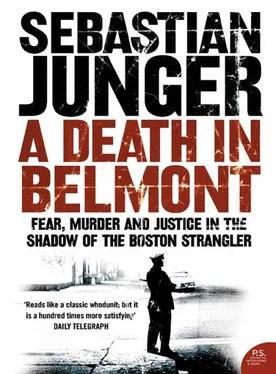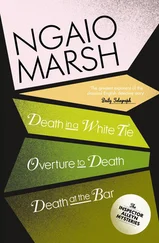The public called the killer the “Boston Strangler,” and a special investigatory unit—the “Strangler Bureau”—had been convened to track him down. They had screened 2,500 sex offenders and brought in 300 of them for close questioning. They had interviewed 5,000 people connected to the victims and combed through half a million fingerprint files. It was the most thorough investigation in Massachusetts history, and their spectacular lack of success was leading the public to attribute nearly supernatural qualities to the killer: He was inhumanly strong; he could break into any apartment, no matter how well-locked; he could kill in minutes and leave no trace at all. Women bought guard dogs. They only went out in pairs. They placed cans in darkened hallways as a sort of early-warning system. One particularly high-strung woman heard someone in her apartment and leaped to her death from her third-floor window rather than face whatever it was. Virtually every month there was another sick, brutal murder in Boston, and the fifty-man tactical police unit—specially trained in karate and quick-draw shooting—was helpless to stop them.
“What I remember about Roy Smith,” says Mike Giacoppo, the Cambridge police officer who arrested him, “is that they had a murder warrant out for him, and that they said it was possible he’d be in Cambridge or in Somerville. I used to work for a power and light company, and they have a database that’s unreal. So I went to the power and light company at night and looked up names. Every time I found an R. Smith moved in or moved out, I’d find a D. Hunt, which was Dorothy Hunt. They would move out without paying their bills, you know; they’d shut ’em off. I finally located her at 93 Brookline Street in Cambridge. And so I went up to the captain, and I says, ‘I got a hunch.’”
Giacoppo’s captain wouldn’t let him do a stakeout on the clock because he was just a rookie, so Giacoppo waited until his shift was over to drive over to 93 Brookline Street. He was in civilian clothes, and he had another rookie friend with him named Billy Coughlin. The house was a triple-decker on a street that ran north-south from the Charles River to the Irish bars and shoe stores of Central Square—a working-class part of Cambridge known as “the Coast.” Giacoppo parked across from 93 Brookline Street and got out of the car and started for a variety store where he planned to ask if anyone knew Dorothy Hunt. Halfway there he saw a little black girl sitting on the stoop, and he stopped in front of her and bent down and asked her instead. The girl said that that was her mother. Is Roy up there? Giacoppo asked. The girl said yes.
Giacoppo and Coughlin had no radio and no backup and were possibly about to arrest the most prolific killer in Boston history. If they drove back to the police station to get help, Smith might escape. If they tried to go in and arrest him, they might find themselves in way over their heads. Giacoppo walked across the street to the variety store to use the telephone, but the owner said he didn’t have one. There was only one thing left to do: He told Coughlin to go up the front stairs of the building and he pulled his gun and went up the back stairs. When he got to the top landing he pounded on the door until a black man named Ronald Walcott finally let him in.
Smith was frozen in an armchair, and Coughlin was pointing his service revolver at his head and screaming that he would shoot him if he moved. Dorothy Hunt and her other young daughter looked on in shock. Smith asked what he was being arrested for, and Coughlin told him that it was suspicion of murder. Smith didn’t say anything in response. “He was in a state of shock,” says Giacoppo. “How would you be if you had a gun to your head? We held a gun to his head all the way. We never handcuffed him—we didn’t even have handcuffs with us! It was sort of a comedy of errors, it was a riot, we did everything wrong.”
They took Smith down the back staircase and then out onto the street, revolvers still pointing at his head. Smith never said a word. One of the cops flagged down a car, and all three men squeezed into the back seat, and Giacoppo yelled at the terrified driver to take them to the police station. The station was just around the corner, and minutes later Smith found himself seated in a chair getting booked by a detective named Leo Davenport. A photograph that appeared on the front page of the Boston Herald shows Davenport in a suit and tie working away on a manual typewriter while Coughlin and Giacoppo and another police officer look on from behind. Smith is seated in a chair with one hand shackled to the armrest and the other cocked up in the air with a cigarette between his first and second fingers. His legs are crossed, and he is looking down at his knees. The accompanying article describes him as a “lean, moustached drifter” who wore a striped sports shirt and shabby brown trousers and ignored the crowd that had gathered around him except to avert his face from the news cameras.
The way Bessie Goldberg died was considered a classic “Boston Strangling,” so Smith’s arrest prompted many local reporters to announce that the Strangler had finally been caught. The few reporters who held back on that announcement resorted to a theme of random violence in the suburbs that was almost as compelling. Until now all the stranglings had occurred in apartment buildings in downtown Boston or in working-class towns north of the city. Bessie Goldberg was the first woman to be killed in a one-family home in an affluent neighborhood, and if a murderer could strike there, he could strike anywhere. “This is Belmont, these things just don’t happen here!” one of Bessie’s neighbors told the Boston Herald . Another reporter described the Goldberg house as a “rambling ten-room colonial … on a street of similarly expensive homes.” In fact it was a modest brick-and-clapboard on a street that virtually overlooked a highway. It was also imagined by the press that Bessie Goldberg had put up a “terrific struggle” for her life, though there was little evidence of that. She had, in fact, died with her glasses on. The details of sexual assault, of course, were respectfully muted.
Whether or not Smith was the Boston Strangler, the case against him for the Goldberg murder was devastating. By his own admission he had been at the Goldberg house most of the afternoon and had left around three o’clock, a fact confirmed by numerous people in the neighborhood. Israel Goldberg had arrived home at ten minutes to four—again confirmed by numerous people—and no one had spotted anyone else going into or out of the Goldberg house during the intervening fifty minutes. The house was in disarray, as if Smith had not finished cleaning, and fifteen dollars that Israel had left on Bessie’s nightstand was missing. As far as the police were concerned, Smith had committed the murder because, realistically, no one else could have. All that remained was for Smith to confess, which—considering the evidence against him—seemed almost inevitable. If Smith confessed to second-degree murder and served his time peacefully, he could expect to be out in fifteen years or so. For a habitual criminal accused of murder in a city terrorized by a serial killer, it wasn’t a bad deal.
IT HAS BEEN forty years since her mother’s murder, and Leah Goldberg—now older than her mother was when she died—still cannot talk about it without getting angry. She is a small, intense woman who speaks her mind sharply and unapologetically, her voice occasionally diving into an outraged whisper that even the person she is speaking to cannot understand. She was living in Cambridge and teaching fifth graders at the Roberts School at the time of the murder; she first heard something was wrong when the operator broke into a phone conversation and said that she had an emergency call for a Leah Goldberg. It was her father. He told her that her mother was sick and to come home as quickly as possible.
Читать дальше












